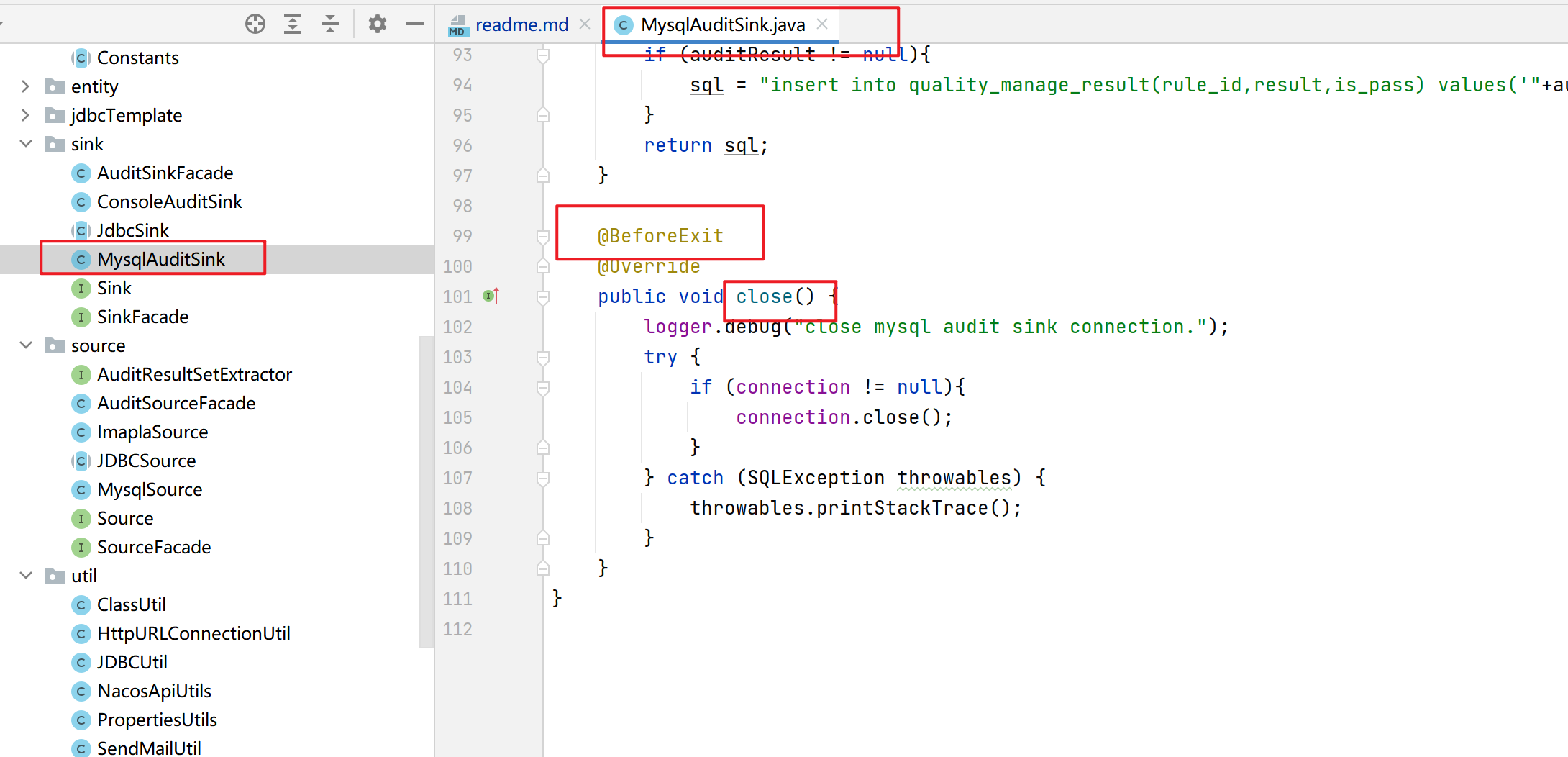quality-manage
一个轻量化、客制化的数据质量管理工具,比Griffin更灵活,更轻巧🍰
1.数据质量管理项目的初衷
数据稽核到业务开发到一定程度后,就需要提到日程了。在调研后发现,开源的稽核工具只有Griffin。
我们公司目前的数据量比较少,一天的数据量最多也就百万、千万级别,而且需要定义一些复杂的sql来实现稽核.在调研的时候使用Griffin进行测试,发现Griffin的内置rule比较少,如下图:

在运行Griffin的时候还有一些小bug,当时解决这个小bug进行了一个偷巧的操作,就没进行PR,jira的issues地址:https://issues.apache.org/jira/browse/GRIFFIN-248
所以想着手写一个简单的没有界面的稽核工具,只通过sql实现稽核,调度的话就放到airflow中进行每日调度
2.项目自定义开发指导
2.1 项目运行流程
当运行QualityApplication主类的时候,需要加上稽核规则id;主程序会根据稽核规则从quality_manage_rule表中读取稽核规则,稽核规则的不通,内部的稽核json都不一样,拿custom_sql.json这个稽核规则来说明
{
"source_type":"SOURCE_MYSQL",
"sql":"select count(1) as result,case when count(1)>1000000 then ''F'' else ''T'' end as is_pass from test_xichuan_database.dws_xichuan_table lid where date(UPDATE_TIME) = date(date_add(now(),interval -1 day)) "
}custom_sql.json稽核规则很简单,一个是数据源类型,一个是稽核的sql。当稽核结束的时候,会将稽核结果写入到quality_manage_result表中
2.2 数据库表与配置文件说明
1.创建稽核规则表与稽核结果表
-- 稽核规则表
CREATE TABLE `quality_manage_rule` (
`id` int(11) NOT NULL,
`name` varchar(64) DEFAULT NULL COMMENT '规则名称',
`audit_type` varchar(128) DEFAULT NULL COMMENT '稽核类型',
`strategy` varchar(128) NOT NULL COMMENT '稽核规则',
`rule_json` text NOT NULL,
`single_value` varchar(156) DEFAULT NULL COMMENT '单个阈值',
`range_min` varchar(156) DEFAULT NULL COMMENT '范围值域下限',
`range_max` varchar(156) DEFAULT NULL COMMENT '范围值域上限',
`notification_level` int(11) DEFAULT '1' COMMENT '警告级别,1,2,3',
`description` text NOT NULL COMMENT '规则描述',
`status` varchar(64) NOT NULL COMMENT '状态,T/F,T执行,F不执行',
`creat_time` timestamp NOT NULL DEFAULT CURRENT_TIMESTAMP,
PRIMARY KEY (`id`)
) ENGINE=InnoDB DEFAULT CHARSET=utf8
-- 稽核结果表
CREATE TABLE `quality_manage_result` (
`id` int(11) NOT NULL AUTO_INCREMENT,
`rule_id` int(11) NOT NULL,
`result` varchar(128) DEFAULT NULL,
`is_pass` varchar(32) DEFAULT NULL,
`creat_time` timestamp NOT NULL DEFAULT CURRENT_TIMESTAMP,
PRIMARY KEY (`id`)
) ENGINE=InnoDB AUTO_INCREMENT=271 DEFAULT CHARSET=utf8
-- 规则示例
insert into quality_manage_rule(id,strategy,rule_json,description,status,range_max)
values(100,'distinct_count','{"source_type":"SOURCE_IMPALA","database":"test_xichuan_database","table":"dws_xichuan_table","column":"td_sequence"}','验证测试','T',null);
insert into quality_manage_rule(id,strategy,rule_json,description,status,range_min,range_max)
values(101,'custom_sql','{"source_type":"SOURCE_MYSQL","sql":"select count(1) as result,case when count(1)>1000000 then ''F'' else ''T'' end as is_pass from test_xichuan_database.dws_xichuan_table lid where date(UPDATE_TIME) = date(date_add(now(),interval -1 day)) "}','验证测试','T',null,null);
2.在default.properties中添加连接配置
注:目前的数据源的连接信息是写死的,并没有开发自动识别数据源类型
# email
email.smtp=smtp.exmail.qq.com
email.smtp.port=-1
email.from.user=xichuan@123.com
email.to.users=886@123.com,889@123.com
email.login.username=xichuan
email.login.password=xichuan123
# db impala
db.impala.url=jdbc:impala://node01:25004/
db.impala.database=default
db.impala.username=impala
db.impala.password=impala
# db mysql
db.mysql.url=jdbc:mysql://node01:3306/
db.mysql.database=default
db.mysql.username=mysql
db.mysql.password=mysql2.3 注解说明
1.@RegisterBean注解:
@RegisterBean注解是将此类注册到容器中管理

2.@StrategyAnnotation注解:
@StrategyAnnotation注解写在策略类上,在运行QualityApplication主类的时候,可以将策略注册进去

3.@BeforeExit注解:
@BeforeExit写在source和sink的close()方法上,这样在程序结束运行前,会自动关闭数据库连接

2.4 开发新Source说明
目前已经开发好的source有impala和mysql
开发新source其实很简单,拿mysql为例:
- 在
MysqlSource类上添加@RegisterBean注解交给容器管理,将MysqlSource类继承JDBCSource抽象类 - 实现
open()与close()方法,并在close()方法上添加@BeforeExit注解,以在程序运行结束前关闭连接 - 在
MysqlSource(JDBCEntity jdbcEntity)构造方法中调用open()方法来创建Connection
/**
* @Author Xichuan
* @Date 2022/4/13 18:42
* @Description
*/
@RegisterBean
public class MysqlSource extends JDBCSource{
private static final String MYSQL_DRIVER = "com.mysql.jdbc.Driver";
public MysqlSource(){
logger = LoggerFactory.getLogger(MysqlSource.class);
}
public MysqlSource(JDBCEntity jdbcEntity)throws Exception{
logger = LoggerFactory.getLogger(MysqlSource.class);
open(jdbcEntity);
}
@Override
public MysqlSource open(JDBCEntity jdbcEntity) throws SQLException, ClassNotFoundException {
logger.debug("open mysql source connection.");
Class.forName(MYSQL_DRIVER);
connection = DriverManager.getConnection(jdbcEntity.getUrl()+ jdbcEntity.getDatabase(), jdbcEntity.getUser(), jdbcEntity.getPassword());
return this;
}
@BeforeExit
@Override
public void close() {
logger.debug("close mysql source connection.");
try {
if (rs != null){
rs.close();
}
if (connection != null){
connection.close();
}
} catch (SQLException throwables) {
throwables.printStackTrace();
}
}
}2.5 开发新Sink说明
目前已经开发好的sink有Console和mysql
开发新JDBC Sink其实很简单,拿mysql为例:
- 在
MysqlAuditSink类上添加@RegisterBean注解交给容器管理,并将MysqlAuditSink类继承JDBCSink抽象类,并实现Sink接口 - 实现
open()、close()和write()方法,并在close()方法上添加@BeforeExit注解,以在程序运行结束前关闭连接 - 在
MysqlAuditSink(JDBCEntity jdbcEntity)构造方法中调用open()方法来创建Connection
/**
* @Author Xichuan
* @Date 2022/4/13 14:17
* @Description
*/
/**
* Mysql Sink
*/
@RegisterBean
public class MysqlAuditSink extends JdbcSink implements Sink<AuditResult> {
private Logger logger = LoggerFactory.getLogger(this.getClass());
private static final String MYSQL_DRIVER = "com.mysql.jdbc.Driver";
public MysqlAuditSink(){}
public MysqlAuditSink(JDBCEntity jdbcEntity)throws Exception{
open(jdbcEntity);
}
@Override
public MysqlAuditSink open(JDBCEntity jdbcEntity) throws SQLException, ClassNotFoundException {
logger.debug("open mysql audit sink connection.");
Class.forName(MYSQL_DRIVER);
connection = DriverManager.getConnection(jdbcEntity.getUrl()+ jdbcEntity.getDatabase(), jdbcEntity.getUser(), jdbcEntity.getPassword());
return this;
}
@Override
public boolean write(AuditResult auditResult) {
Boolean executeFlag = false;
try {
if (connection == null){
logger.error("Mysql connection is not initialized!");
return false;
}
if (auditResult == null){
logger.warn("AuditResult is null!");
return false;
}
String sql = joinSql(auditResult);
logger.info("audit mysql sink sql:"+sql);
if (StringUtils.isNotBlank(sql)){
executeFlag = writeToDB(sql);
}
} catch (Exception e) {
logger.error("writes the result to Mysql and reports an error!," + e.getMessage());
e.printStackTrace();
}
return executeFlag;
}
/**
* 拼接sql
* @param auditResult
* @return
*/
private String joinSql(AuditResult auditResult){
String sql = "";
if (auditResult != null){
sql = "insert into quality_manage_result(rule_id,result,is_pass) values('"+auditResult.getRuleId()+"','"+auditResult.getResult()+"','"+auditResult.getIsPass()+"')";
}
return sql;
}
@BeforeExit
@Override
public void close() {
logger.debug("close mysql audit sink connection.");
try {
if (connection != null){
connection.close();
}
} catch (SQLException throwables) {
throwables.printStackTrace();
}
}
}2.6 已经有的稽核rule说明
distinct_count:
说明:判断某个字段的去重count是否在一个上下范围内,阈值的设置在稽核规则表的range_min与range_max字段上设置
{
"source_type":"SOURCE_IMPALA",
"database":"test_xichuan_database",
"table":"test_xichuan_table",
"column":"sequence"
}total_count:
说明:判断某字段的总数是否在一个上下范围内,阈值的设置在稽核规则表的range_min与range_max字段上设置
{
"source_type":"SOURCE_IMPALA",
"database":"test_xichuan_database",
"table":"test_xichuan_table",
"column":"sequence"
}custom_sql:
说明:自定义sql稽核,稽核后的结果字段是is_pass,T:稽核通过,F:稽核不通过
{
"source_type":"SOURCE_MYSQL",
"sql":"select count(1) as result,case when count(1)>1000000 then ''F'' else ''T'' end as is_pass from test_xichuan_database.dws_xichuan_table lid where date(UPDATE_TIME) = date(date_add(now(),interval -1 day)) "
}下面是未完成的稽核规则:
null_count:
说明:空值阈值判断稽核
{
"source_type":"mysql",
"database":"mysql_db",
"table":"",
"column":""
}single_value_check:
说明:单值检测稽核
{
"source_type":"mysql",
"database":"mysql_db",
"table":"",
"column":""
}two_value_compare:
说明:两值比较稽核
{
"source_type":"mysql",
"database":"mysql_db",
"table_one":"",
"table_one_column":"",
"table_two":"",
"table_two_column":""
}2.7 开发新稽核rule说明
因为已经封装了稽核规则抽象类,稽核规则开发其实也很简单,我们拿DistinctCount这个稽核rule来举例:
- 在
DistinctCount类上添加@RegisterBean与@StrategyAnnotation与注解,从而在程序开始运行的时候将该rule注册到稽核容器中 - 继承
AbstractStrategy抽象类,并实现parseJson()方法来解析rule的json规则;实现resolve()方法来实现稽核处理,并输出稽核结果
/**
* @Author Xichuan
* @Date 2022/4/13 15:55
* @Description
*/
@RegisterBean
@StrategyAnnotation(name = "distinct_count",description = "distinct数量校验")
public class DistinctCount extends AbstractStrategy<BaseRule> implements Strategy {
private static Logger logger = LoggerFactory.getLogger(DistinctCount.class);
/**
* 解析RuleJson
* @param ruleJson
* @return
*/
@Override
protected BaseRule parseRuleJson(String ruleJson) {
return JSON.parseObject(ruleJson,BaseRule.class);
}
/**
* 具体处理逻辑
* @param auditRule
* @param sourceFacade
* @param sinkFacade 输出类
* @return
*/
@Override
public AuditResult resolve(AuditRule auditRule, SourceFacade sourceFacade, SinkFacade sinkFacade) {
AuditResult auditResult = null;
try {
//source
JDBCSource source = (JDBCSource) sourceFacade.get(rule.getSourceType());
if (source == null){
logger.warn("source is null !");
return auditResult;
}
// execute
String sql = MessageFormat.format("select count(distinct {0}) as ct from {1}.{2}",rule.getColumn(),rule.getDatabase(),rule.getTable());
Integer count = source.read(sql, rs -> {
Integer ct = 0;
while (rs.next()){
ct = rs.getInt("ct");
}
return ct;
});
//sink result
auditResult = new AuditResult();
auditResult.setResult(String.valueOf(count));
auditResult.setIsPass(Constants.RULE_RESULT_PASS);
auditResult.setRuleId(auditRule.getId());
} catch (Exception e) {
logger.error("run distinct_count rule exception!,"+e.getMessage());
e.printStackTrace();
}
return auditResult;
}
}3.项目运行示例
4.其他
此项目只是简单的实现数据稽核功能,只是一个小小的架子,以避免写一堆重复的稽核代码。项目中还有许多不完善的地方,希望理解,代码虽然不复杂,但希望可以帮助到你






